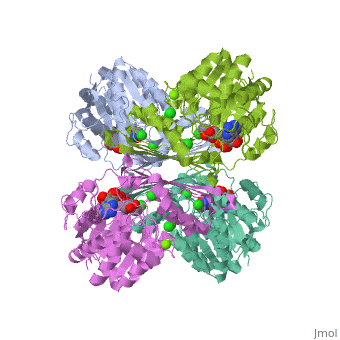Sandbox 71
From Proteopedia
| Line 1: | Line 1: | ||
| - | {{ | + | {{STRUCTURE_2d1s | PDB=3cin | SCENE= }} |
| - | + | '''[[Luciferase]]''' | |
| - | + | ||
| - | + | ||
| - | + | ||
| - | + | This isn't your normal human molecule but, its normal for fireflies. The molecule called the "Luciferase". The molecule has an ability to emit light by going through a complicated energy process that requires the breaking of 8 ATP molecules.So, luciferase uses a very energetic process to create light. It has a cofactor, termed a luciferin, that forms a highly strained complex with oxygen, using an ATP molecule to help set everything up. When this oxygenated luciferin breaks, forming carbon dioxide in the process, it leaves behind a highly excited form that then emits the light. | |
| - | + | ||
| - | + | ||
| + | '''[[Structure]]''' | ||
| + | If you look closely at the molecule you can see a bundled group of molecule, you can see that group plays an important role. It can emit light and in order to glow, it takes up energy to break up the ATP molecules so they can emit the excited carbon dioxide formed Luciferin. | ||
Revision as of 12:21, 7 May 2009
| |||||||||
| 2d1s, resolution 1.30Å () | |||||||||
|---|---|---|---|---|---|---|---|---|---|
| Ligands: | , | ||||||||
| Non-Standard Residues: | |||||||||
| Activity: | Photinus-luciferin 4-monooxygenase (ATP-hydrolyzing), with EC number 1.13.12.7 | ||||||||
| Related: | 2d1r, 2d1t | ||||||||
| |||||||||
| |||||||||
| Resources: | FirstGlance, OCA, PDBsum, RCSB, TOPSAN | ||||||||
| Coordinates: | save as pdb, mmCIF, xml | ||||||||
This isn't your normal human molecule but, its normal for fireflies. The molecule called the "Luciferase". The molecule has an ability to emit light by going through a complicated energy process that requires the breaking of 8 ATP molecules.So, luciferase uses a very energetic process to create light. It has a cofactor, termed a luciferin, that forms a highly strained complex with oxygen, using an ATP molecule to help set everything up. When this oxygenated luciferin breaks, forming carbon dioxide in the process, it leaves behind a highly excited form that then emits the light.
Structure
If you look closely at the molecule you can see a bundled group of molecule, you can see that group plays an important role. It can emit light and in order to glow, it takes up energy to break up the ATP molecules so they can emit the excited carbon dioxide formed Luciferin.


